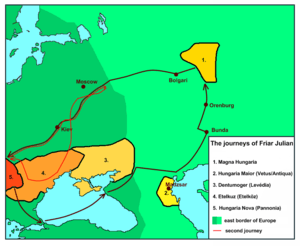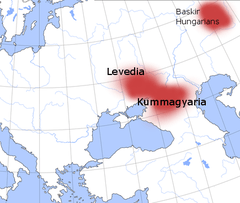Eastern Hungarians
"Eastern Hungarians"[1][2] or "Eastern Magyars"[3] is a broad term for groups of Hungarians who remained in Eastern Europe during the Migration Period and did not participate in the Hungarian conquest.
Magyars in Magna Hungaria

Friar Julian named the country of the Eastern Hungarians for Magna Hungaria (Great Hungary). It was roughly situated in the area of present-day Bashkortostan. Before the start of the Mongol Invasion, Julian was able to reach the territory bordered by the rivers Volga – Kama – Belaya – Ural as a companion to a Muslim priest. There he found the Hungarians and found, which the chronicles of the time referred to as Magna Hungaria. Julian was even able to communicate with them in Hungarian (despite the gap of at least 300–400 years since the split).[4] He set off home anxious to give account on his mission, as well as the news he gathered about the upcoming invasion of the Mongols.
Savard Magyars
In the 8th century, the Savard Hungarians, one section of the Hungarian people, broke off and moved to the country south of the Caucasus.[5] Contemporary Byzantine source reports that around the mid- tenth century the Hungarians maintained contact with the Savard Hungarians who remained in Eastern Europe.[6]
Alternative theories
Kummagyaria
According to the theory of Kummagyaria, before the Mongol invasion of Europe, the Hungarians who remained in Eastern Europe and did not participate in the Hungarian conquest possessed a country northwards from Caucasus. According to Laszlo Bendefy, the approximate location of Kummagyaria is the riparian area of the Kuma River, Southern Russia.
Papal bulls by Popes Innocent IV in 1253, Alexander IV in 1258 and Michael IV in 1288 and 1291 made reference to Kummagyaria, (spelled as Cummageria). A bull proclaimed by Pope John XXII in 1329 is addressed to Gyeretyán, who was the then chieftain of Kummagyaria.
Odorico Raynaldi wrote a commentary on the occasion of the bull’s proclamation:
"The Pope was informed of the Asian Magyars’, the Malkaites’, and the Alans’ firm commitment to the one true religion. These nations, despite being surrounded by a net of godless, superstitious rites, have maintained their immaculate belief in their faith. A highlight in this regard is Jeretany, the descendant of royal Magyar blood. Since he requested a Catholic emmissary from the Holy See, the Pope sent the bishop of Samarkand to him, in order to strengthen their faith, and to implore the religious men among them to remain steadfast."
Odorico Raynaldi
The bull contained the following text:
"Greetings to our dear children, to Jeretany and all Christian Magyars, Malkaites & Alans! It has caused us rather great and natural happiness, that the Most Esteemed Creator, whose summons is constant and spreads to the entire world, to all those whom He chooses to discover His mercifulness, and for his only Son, with his love that is indescribable in words that constantly envelopes every single Christian family, embraces you, who have been touched by the true faith, the teaching of the Scriptures and the light of the Apostolic Church, amongst those of the Eastern parts of the world who are yet to accept the graces of Christianity."
Avignon, October 3rd of the 14th year
In 1569, Andrzej Taranowski, a diplomat of the Polish king Sigismund II Augustus, was returning from Constantinople, heading towards Astrakhan. In his journal he wrote:[7]
"On the night of October 7th we made camp amongst the gravemounds of the Magyars. Even today there are many ruins of buildings to be found, the ruins of the temples of the pagan Magyars... their territory comes to an end at the Sasyk River. As we passed through their former territory we saw ruins of fortifications every day, the ruins of the former Magyar temples. The steppe contains Magyar grave mounds that are abundant in treasures, Fortifications made of enormous stones that are now covered in moss are in abundance. The last inhabitants of this land were Christians, most likely the Cherkes."
Andrzej Taranowski
In 1712, the French traveller Aubrey de la Motraye passed through the area. His notes state that from what he heard from the local Tatar population, he maintained that the city of Mazsar was formerly inhabited by Magyars.[7]
See also
Notes
- ↑ Pál Engel, Tamás Pálosfalvi, Andrew Ayton, Realm of St. Stephen: A History of Medieval Hungary, I.B.Tauris, 2005, p. 99
- ↑ Iván Boldizsár, The New Hungarian Quarterly, Volume 29, Lapkiadó Publishing House, 1988, p. 127
- ↑ András Róna-Tas, Chuvash studies, Akadémiai Kiadó, 1982, p. 52
- ↑ Arnold Joseph Toynbee, Constantine Porphyrogenitus and his world, Oxford University Press, 1973, p. 421
- ↑ Lajos Gubcsi, Hungary in the Carpathian Basin, MoD Zrínyi Media Ltd, 2011
- ↑ Alfried Wieczorek, Hans-Martin Hinz, Council of Europe. Art Exhibition, Europe's centre around AD 1000, Volume 1, Theiss, 2000, p. 365
- 1 2 Tardy, Lajos. ’’Régi hírünk a világban’’, Gondolat, Budapest, 1979
